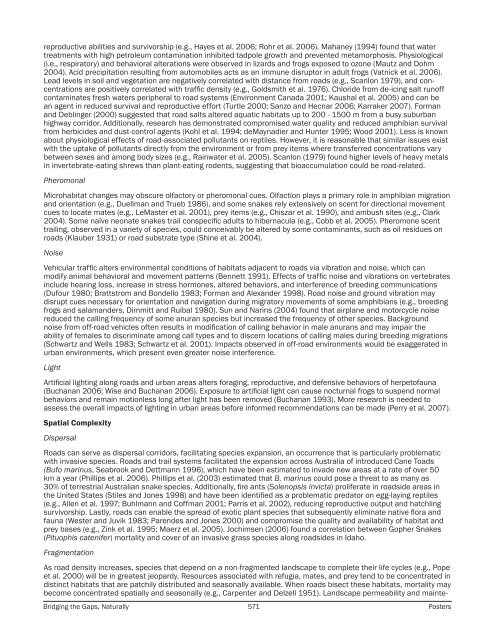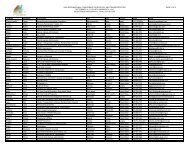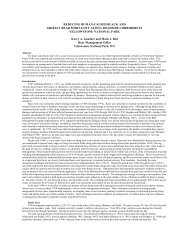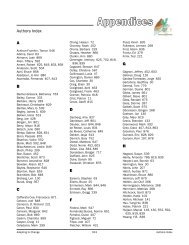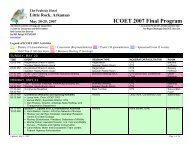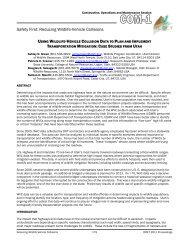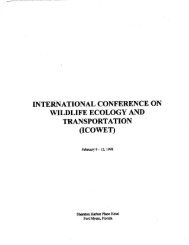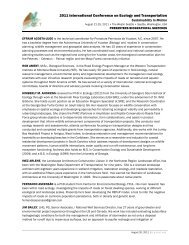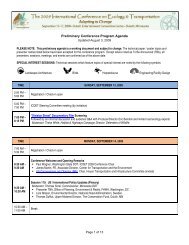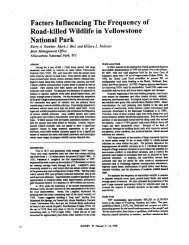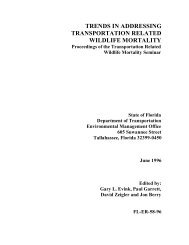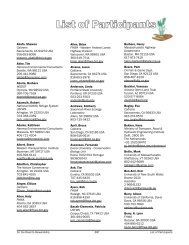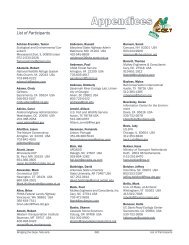Poster Sessions, pages 567-640 - ICOET
Poster Sessions, pages 567-640 - ICOET
Poster Sessions, pages 567-640 - ICOET
Create successful ePaper yourself
Turn your PDF publications into a flip-book with our unique Google optimized e-Paper software.
eproductive abilities and survivorship (e.g., Hayes et al. 2006; Rohr et al. 2006). Mahaney (1994) found that water<br />
treatments with high petroleum contamination inhibited tadpole growth and prevented metamorphosis. Physiological<br />
(i.e., respiratory) and behavioral alterations were observed in lizards and frogs exposed to ozone (Mautz and Dohm<br />
2004). Acid precipitation resulting from automobiles acts as an immune disruptor in adult frogs (Vatnick et al. 2006).<br />
Lead levels in soil and vegetation are negatively correlated with distance from roads (e.g., Scanlon 1979), and concentrations<br />
are positively correlated with traffic density (e.g., Goldsmith et al. 1976). Chloride from de-icing salt runoff<br />
contaminates fresh waters peripheral to road systems (Environment Canada 2001; Kaushal et al. 2005) and can be<br />
an agent in reduced survival and reproductive effort (Turtle 2000; Sanzo and Hecnar 2006; Karraker 2007). Forman<br />
and Deblinger (2000) suggested that road salts altered aquatic habitats up to 200 - 1500 m from a busy suburban<br />
highway corridor. Additionally, research has demonstrated compromised water quality and reduced amphibian survival<br />
from herbicides and dust-control agents (Kohl et al. 1994; deMaynadier and Hunter 1995; Wood 2001). Less is known<br />
about physiological effects of road-associated pollutants on reptiles. However, it is reasonable that similar issues exist<br />
with the uptake of pollutants directly from the environment or from prey items where transferred concentrations vary<br />
between sexes and among body sizes (e.g., Rainwater et al. 2005). Scanlon (1979) found higher levels of heavy metals<br />
in invertebrate-eating shrews than plant-eating rodents, suggesting that bioaccumulation could be road-related.<br />
Pheromonal<br />
Microhabitat changes may obscure olfactory or pheromonal cues. Olfaction plays a primary role in amphibian migration<br />
and orientation (e.g., Duellman and Trueb 1986), and some snakes rely extensively on scent for directional movement<br />
cues to locate mates (e.g., LeMaster et al. 2001), prey items (e.g., Chiszar et al. 1990), and ambush sites (e.g., Clark<br />
2004). Some naïve neonate snakes trail conspecific adults to hibernacula (e.g., Cobb et al. 2005). Pheromone scent<br />
trailing, observed in a variety of species, could conceivably be altered by some contaminants, such as oil residues on<br />
roads (Klauber 1931) or road substrate type (Shine et al. 2004).<br />
Noise<br />
Vehicular traffic alters environmental conditions of habitats adjacent to roads via vibration and noise, which can<br />
modify animal behavioral and movement patterns (Bennett 1991). Effects of traffic noise and vibrations on vertebrates<br />
include hearing loss, increase in stress hormones, altered behaviors, and interference of breeding communications<br />
(Dufour 1980; Brattstrom and Bondello 1983; Forman and Alexander 1998). Road noise and ground vibration may<br />
disrupt cues necessary for orientation and navigation during migratory movements of some amphibians (e.g., breeding<br />
frogs and salamanders, Dimmitt and Ruibal 1980). Sun and Narins (2004) found that airplane and motorcycle noise<br />
reduced the calling frequency of some anuran species but increased the frequency of other species. Background<br />
noise from off-road vehicles often results in modification of calling behavior in male anurans and may impair the<br />
ability of females to discriminate among call types and to discern locations of calling males during breeding migrations<br />
(Schwartz and Wells 1983; Schwartz et al. 2001). Impacts observed in off-road environments would be exaggerated in<br />
urban environments, which present even greater noise interference.<br />
Light<br />
Artificial lighting along roads and urban areas alters foraging, reproductive, and defensive behaviors of herpetofauna<br />
(Buchanan 2006; Wise and Buchanan 2006). Exposure to artificial light can cause nocturnal frogs to suspend normal<br />
behaviors and remain motionless long after light has been removed (Buchanan 1993). More research is needed to<br />
assess the overall impacts of lighting in urban areas before informed recommendations can be made (Perry et al. 2007).<br />
Spatial Complexity<br />
Dispersal<br />
Roads can serve as dispersal corridors, facilitating species expansion, an occurrence that is particularly problematic<br />
with invasive species. Roads and trail systems facilitated the expansion across Australia of introduced Cane Toads<br />
(Bufo marinus, Seabrook and Dettmann 1996), which have been estimated to invade new areas at a rate of over 50<br />
km a year (Phillips et al. 2006). Phillips et al. (2003) estimated that B. marinus could pose a threat to as many as<br />
30% of terrestrial Australian snake species. Additionally, fire ants (Solenopsis invicta) proliferate in roadside areas in<br />
the United States (Stiles and Jones 1998) and have been identified as a problematic predator on egg-laying reptiles<br />
(e.g., Allen et al. 1997; Buhlmann and Coffman 2001; Parris et al. 2002), reducing reproductive output and hatchling<br />
survivorship. Lastly, roads can enable the spread of exotic plant species that subsequently eliminate native flora and<br />
fauna (Wester and Juvik 1983; Parendes and Jones 2000) and compromise the quality and availability of habitat and<br />
prey bases (e.g., Zink et al. 1995; Maerz et al. 2005). Jochimsen (2006) found a correlation between Gopher Snakes<br />
(Pituophis catenifer) mortality and cover of an invasive grass species along roadsides in Idaho.<br />
Fragmentation<br />
As road density increases, species that depend on a non-fragmented landscape to complete their life cycles (e.g., Pope<br />
et al. 2000) will be in greatest jeopardy. Resources associated with refugia, mates, and prey tend to be concentrated in<br />
distinct habitats that are patchily distributed and seasonally available. When roads bisect these habitats, mortality may<br />
become concentrated spatially and seasonally (e.g., Carpenter and Delzell 1951). Landscape permeability and mainte-<br />
Bridging the Gaps, Naturally 571 <strong>Poster</strong>s


